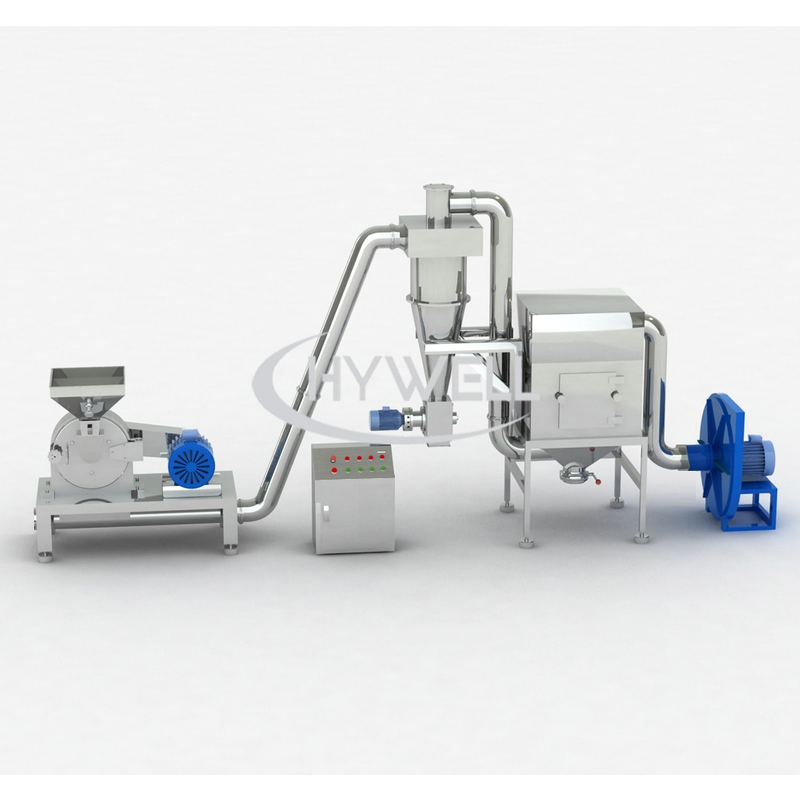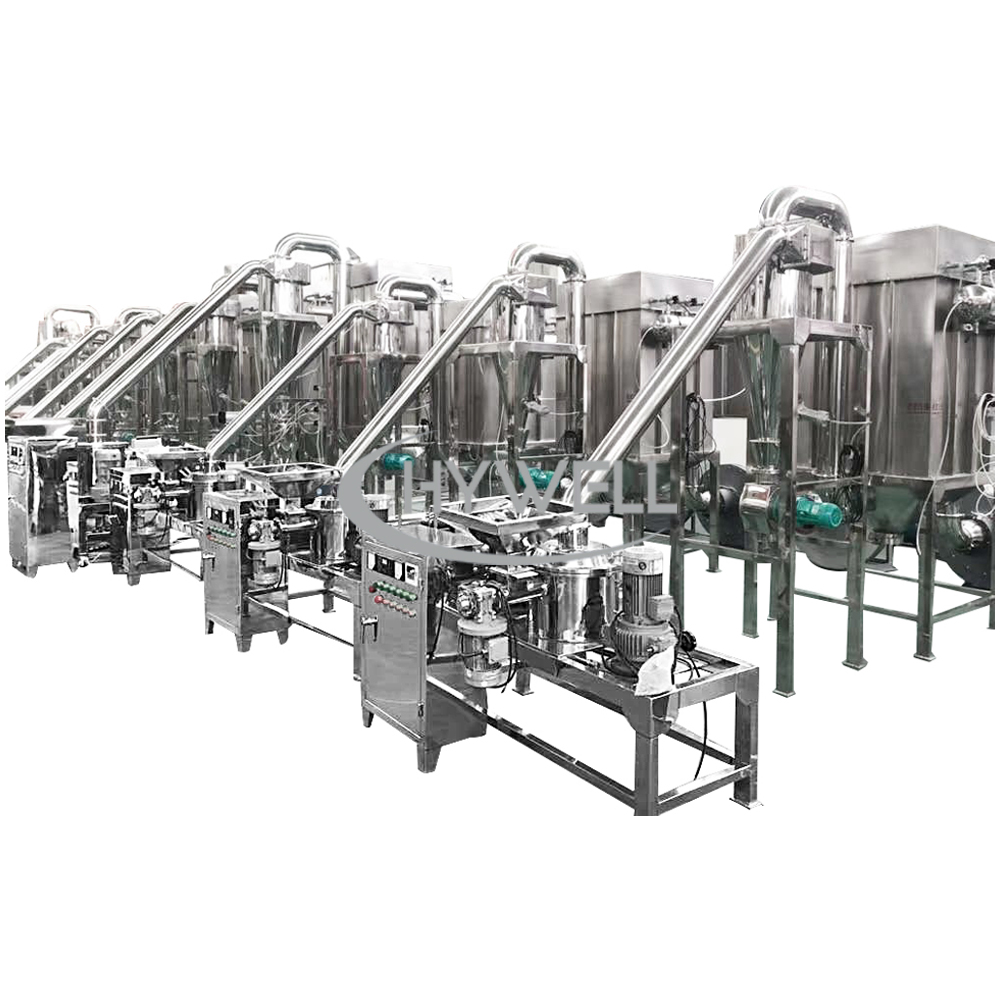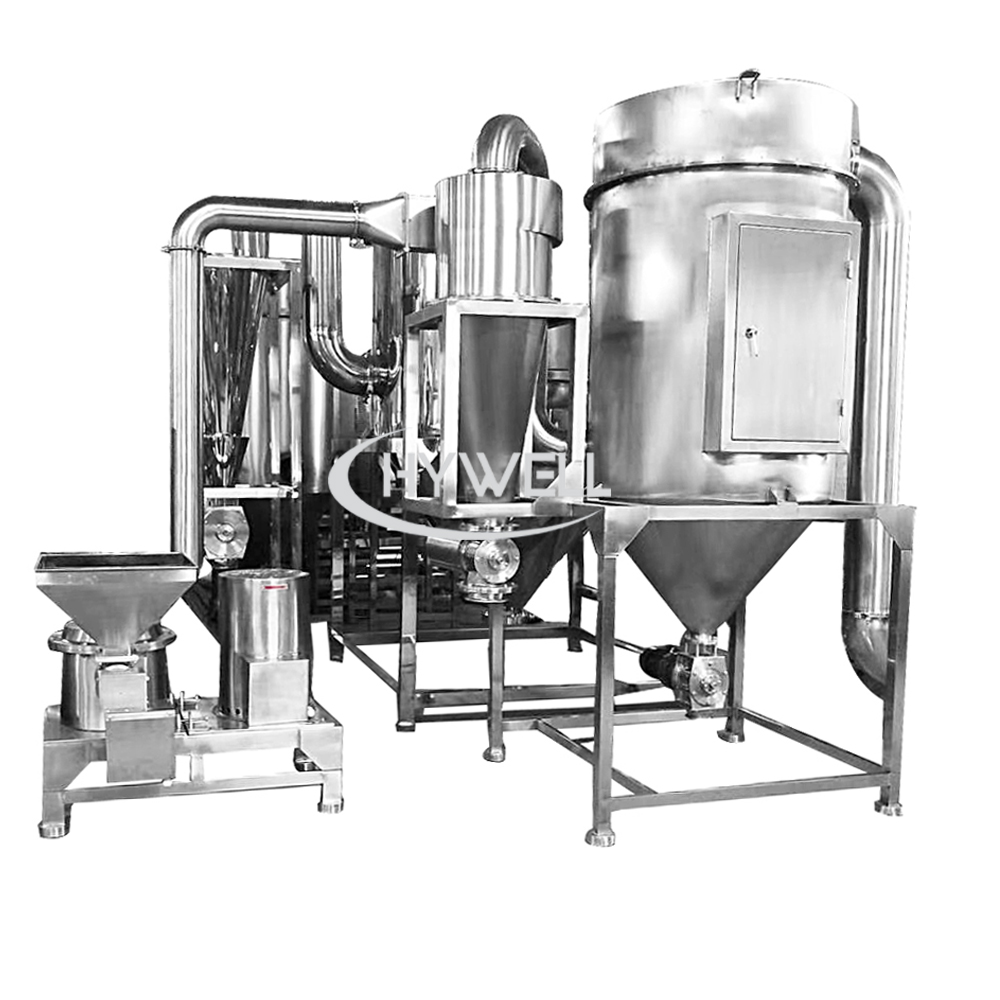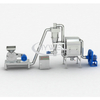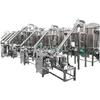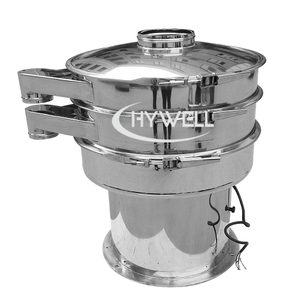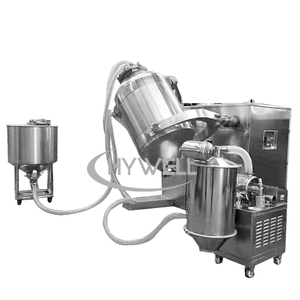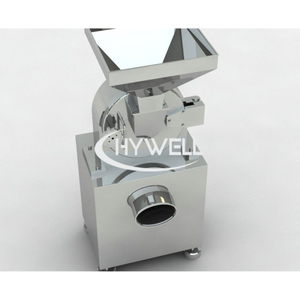Air Classifier Mill Principles
Air classifier mill material would be conveyed by the feeding system evenly to the milling chamber, and would be impacted by a high-speed rotating beater, and also under the centrifugal force, it would impact the grinding track. By several different pulverization powers, the material would be milled into fine powder. The milled powder would go with air flow up to the classifying chamber. With the help of an adjustable classifier wheel, coarse powder and fine powder would be separated. The qualified fine powder would go through the wheel vane and then into the cyclone separator or dust collector, while the mixture of coarse powder and fine powder would fall down to the milling chamber to be milled again. The air classifier mill to grinding the dry powder into 150-500mesh , so if it just wants to get 20-100mesh dry powder, it can use the pin mill, and the cost is also lower.
Air Classifier Mill For Superfine Rice
Air Classifier Mill Specifications
Model | WF-15 | WF-18 | WF-30 | WF-60 | WF-80 |
Capacity (kg/h) | 20-200 | 30-450 | 50-750 | 80-1000 | 100-1300 |
Input materials size (mm) | <10mm | <10mm | <10mm | <10mm | <10mm |
Output materials Fineness (mesh) | 80-600 | 80-600 | 80-600 | 80-600 | 80-600 |
Weight (Kg) | 1100 | 1300 | 1800 | 3200 | 4000 |
| 1.Hywell machinery reserves the right to the design without notice 2.All specifications of the air classifier mill are as accurate as is reasonably possible, but they are not binding. |
What is an Air Classifier Mill?
An air classifier crusher is a type of impact mill that utilizes air classification to separate particles based on their size and shape. It consists of a grinding chamber, where the particles are subjected to high-speed impact by rotating hammers or pins. Simultaneously, a controlled air stream carries the particles to the classifier wheel, where they are classified based on their size.

Crusher head

Cloth bag filter

Crusher head

Crusher head
Air Classifer Mill Operation Video
Advantages of Using an Air Classifier Mill
Air classifier mills offer several advantages over traditional mills. Let's explore some of the key benefits:
Efficient Particle Size Reduction
One of the primary advantages of an air classifying mill is its efficient particle size reduction capabilities. The combination of impact grinding and air classification allows for precise control over the final particle size distribution. This is essential for industries that require a specific particle size range to meet product specifications.
Versatility in Processing Different Materials
air classifying mills are highly versatile machines that can handle a wide range of materials. Whether it's grinding powders, granules, or even fibrous materials, these mills can effectively process various substances. This makes them suitable for diverse industries such as pharmaceuticals, chemicals, food, and cosmetics.
Precise Control over Particle Size Distribution
With an air-classifying crusher, manufacturers can achieve precise control over the particle size distribution of their products. By adjusting the classifier wheel speed, airflow, and other parameters, operators can fine-tune the desired particle size range. This level of control ensures consistent product quality and meets the stringent requirements of many applications.
Low Energy Consumption
Air classifier mills are designed to be energy-efficient. The grinding and classification processes occur in a single machine, eliminating the need for separate equipment. This not only saves space but also reduces energy consumption compared to traditional grinding and classification systems. The compact design and optimized airflow also contribute to energy savings.
Air Classifier Mill Advantages
Hywell machinery super fine air swept classifier mill had the following advantages over conventional solutions.
1. Air classifier mill gets fineness powder
Air classifier mill crush and classifying in one system. Required product size is achieved by the adjustment of the classifier wheel.
2. Air classifier mills have a compact structure
Small space occupation, low installation power, wide application, and high-performance cost.
3. Air-swept classifier mills have high milling efficiency constructure
Different beater designs, pin shapes, hammer shapes, and tooth shapes, for different materials.
Air Classifier Mills Application
Air classifier mills find applications across various industries due to their versatility and efficiency. Let's explore some of the common applications:
Pharmaceutical Industry
In the pharmaceutical industry, maintaining precise particle size distribution is crucial for drug formulation and manufacturing. Air classifier mills are used to reduce the particle size of active pharmaceutical ingredients (APIs) and excipients. They enable the production of uniform and consistent powders, improving the dissolution rate, bioavailability, and overall performance of pharmaceutical products.
Chemical Industry
The chemical industry utilizes air classifier mills for a wide range of applications, including grinding and classifying chemicals, pigments, dyes, and additives. These super fine crushers ensure the production of fine and homogeneous particles, enabling enhanced mixing, dispersibility, and reactivity of chemical substances.
Food Industry
In the food industry, particle size reduction is crucial for various processes such as grinding spices, milling grains, and pulverizing food ingredients. Air classifier mills are employed to achieve uniform particle sizes, which enhance the flavor, texture, and appearance of food products. Additionally, these mills can be used for size reduction in the production of powdered beverages, spices, and nutritional supplements.
Cosmetics Industry
In the cosmetics industry, air classifier mills are utilized to process various cosmetic ingredients, including pigments, powders, and fillers. These superfine powder crushers ensure the production of fine and consistent particles, allowing for the formulation of high-quality cosmetic products such as foundations, blushes, eyeshadows, and powders.
How Does the Air Classifier Mill Work?
The air classifier mill is a vertical grinding mill incorporating an internal air classifying wheel with an independent drive.
The product is fed into the grinding chamber by either a feed screw or a pneumatic conveying system via a rotary feed valve.
The product is impacted by the high-speed grinding media, which causes the feed product to fracture and be thrown by the centrifugal force to the wall of the grinding chamber, which in turn, causes the product to fracture further. The fractured particles are entrained in the induced airflow liberating the outside wall of the internal baffle assembly, which is fitted with air baffles to laminar the airflow. The laminar airflow and particles pass to the internal classifier, which is rotating, in the same direction as the rotor disc. Oversized particles rejected by the centrifugal force applied by the classifying wheel are thrown to the inner wall of the baffle and move down by gravity and by the pressure created by the classifier. These oversized particles are then re-entrained into the grinding zone where further impact occurs.
The material to be crushed is conveyed from the hopper to the grinding chamber by the variable feed screw mechanism. The grinding occurs when the product meets a pin or bar-type rotor disc. As particles are reduced in size they are entrained by the Airstream which enters below the rotor and is carried up between the inner wall and shroud ring with baffles, the particles are then deflected by an air dispersion ring to the separator assembly. Acceptable product is drawn through the exhaust and is collected by a high-efficiency bag filter. Oversize particles are carried downward by the internally circulating air stream and return to Rotor for additional grinding.
Factors to Consider when Choosing an Air Classifier Mill
When selecting an air classifier mill for a specific application, several factors need to be taken into consideration:
Capacity and Throughput
The required capacity and throughput of the mill should align with the production requirements. It is crucial to choose a mill that can handle the desired volume of material efficiently.
Particle Size Range
Different applications require specific particle size ranges. Ensure that the selected mill can achieve the desired particle size distribution consistently.
Material Characteristics
Consider the characteristics of the materials being processed, such as their hardness, moisture content, and abrasiveness. Certain materials may require specialized features or additional equipment attachments to optimize the grinding and classification process.
Maintenance and Operational Costs
Evaluate the maintenance requirements and operational costs associated with the air classifier mill. Consider factors such as ease of cleaning, availability of spare parts, and energy consumption. Choosing a mill with low maintenance and operational costs can contribute to long-term cost savings.
Common Challenges and Troubleshooting Tips
While air classifier mills offer numerous benefits, they can also face certain challenges during operation. Here are some common challenges and troubleshooting tips:
Excessive Fines or Oversized Particles
If the mill produces an excessive amount of fines or oversized particles, it may indicate an issue with the classifier wheel speed or the feed rate. Adjusting these parameters can help achieve the desired particle size distribution.
Uneven Particle Size Distribution
Inconsistent particle size distribution can be caused by improper adjustment of the classifier wheel or inadequate airflow. Check and adjust these parameters to ensure a uniform particle size distribution.
Equipment Clogging
Clogging of the mill can occur due to the accumulation of fine particles or sticky materials. Regular cleaning and maintenance of the mill, including the removal of any blockages, can help prevent clogging issues.
Air Classifier Mill Noise and Dust Control
Air classifier mills can generate noise and dust during operation. Implementing proper noise control measures, such as acoustic enclosures or sound-absorbing materials, can help reduce noise levels. Effective dust collection systems should be installed to minimize airborne dust and maintain a clean working environment.
Conclusion
Air classifier mills are valuable tools in the field of particle size reduction, offering efficient and precise control over particle size distribution. Their versatility makes them suitable for a wide range of industries, including pharmaceuticals, chemicals, food, and cosmetics. By selecting the right mill for specific applications and addressing common challenges, manufacturers can achieve optimal results in terms of product quality, efficiency, and cost-effectiveness.
FAQs (Frequently Asked Questions)
1. Can an air classifier crushing machine handle abrasive materials?
Yes, air classifier crushing machines can effectively handle abrasive materials by incorporating wear-resistant components and liners in their design.
2. Are air classifier mills suitable for processing heat-sensitive materials?
Yes, an air classifier grinder can be designed to handle heat-sensitive materials by implementing cooling systems and controlling the temperature during the grinding process.
3. What is the typical energy consumption of an air classifier mill?
The energy consumption of an air classifier grinding machine can vary depending on the specific model and process parameters. However, in general, air classifier mills are known for their energy-efficient operation compared to traditional grinding and classification systems.
4. Can air classifier mills achieve sub-micron particle sizes?
Yes, with proper adjustments and fine-tuning, air classifier mills can achieve sub-micron particle sizes, making them suitable for applications that require ultrafine grinding.
5. How often should an air classifier mill be cleaned and maintained?
Regular cleaning and maintenance are essential to ensure the optimal performance of an air classifier mill. The frequency of cleaning and maintenance depends on factors such as the type of material being processed and the operating conditions. It is recommended to follow the manufacturer's guidelines for maintenance intervals and procedures.
English
Русский
العربية
Français
Español
Português
Deutsch
italiano
日本語
한국어
Nederlands
Tiếng Việt
ไทย
Polski
Türkçe
ພາສາລາວ
Bahasa Melayu
Filipino
Bahasa Indonesia
magyar
Română
Čeština
қазақ
Српски
हिन्दी
فارسی
Slovenčina
Slovenščina
Norsk
Svenska
українська
Ελληνικά
Suomi
Հայերեն
עברית
Dansk
اردو
বাংলা
Hrvatski
Afrikaans
Gaeilge
Eesti keel
Māori
नेपाली
Oʻzbekcha
latviešu
Azərbaycan dili
Беларуская мова
Български
ქართული
Kurdî
Кыргызча

 简体中文
简体中文